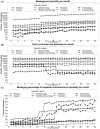Growth of Secure Messaging Through a Patient Portal as a Form of Outpatient Interaction across Clinical Specialties
- PMID: 26171076
- PMCID: PMC4493331
- DOI: 10.4338/ACI-2014-12-RA-0117
Growth of Secure Messaging Through a Patient Portal as a Form of Outpatient Interaction across Clinical Specialties
Abstract
Objective: Patient portals are online applications that allow patients to interact with healthcare organizations. Portal adoption is increasing, and secure messaging between patients and healthcare providers is an emerging form of outpatient interaction. Research about portals and messaging has focused on medical specialties. We characterized adoption of secure messaging and the contribution of messaging to outpatient interactions across diverse clinical specialties after broad portal deployment.
Methods: This retrospective cohort study at Vanderbilt University Medical Center examined use of patient-initiated secure messages and clinic visits in the three years following full deployment of a patient portal across adult and pediatric specialties. We measured the proportion of outpatient interactions (i.e., messages plus clinic visits) conducted through secure messaging by specialty over time. Generalized estimating equations measured the likelihood of message-based versus clinic outpatient interaction across clinical specialties.
Results: Over the study period, 2,422,114 clinic visits occurred, and 82,159 unique portal users initiated 948,428 messages to 1,924 recipients. Medicine participated in the most message exchanges (742,454 messages; 78.3% of all messages sent), followed by surgery (84,001; 8.9%) and obstetrics/gynecology (53,424; 5.6%). The proportion of outpatient interaction through messaging increased from 12.9% in 2008 to 33.0% in 2009 and 39.8% in 2010 (p<0.001). Medicine had the highest proportion of outpatient interaction conducted through messaging in 2008 (23.3% of outpatient interactions in medicine). By 2010, this proportion was highest for obstetrics/gynecology (83.4%), dermatology (71.6%), and medicine (56.7%). Growth in likelihood of message-based interaction was greater for anesthesiology, dermatology, obstetrics/gynecology, pediatrics, and psychiatry than for medicine (p<0.001).
Conclusions: This study demonstrates rapid adoption of secure messaging across diverse clinical specialties, with messaging interactions exceeding face-to-face clinic visits for some specialties. As patient portal and secure messaging adoption increase beyond medicine and primary care, research is needed to understand the implications for provider workload and patient care.
Keywords: Patient portal; consumer health informatics; patient engagement; secure messaging.
Conflict of interest statement
Gretchen Jackson reports salary support from funding provided to VUMC by West Health for projects not related to the submitted work. All other authors have no reported conflicts of interest related to the research.
Figures



Similar articles
-
Rapid growth in surgeons' use of secure messaging in a patient portal.Surg Endosc. 2016 Apr;30(4):1432-40. doi: 10.1007/s00464-015-4347-y. Epub 2015 Jun 27. Surg Endosc. 2016. PMID: 26123340 Free PMC article.
-
Adoption of Secure Messaging in a Patient Portal across Pediatric Specialties.AMIA Annu Symp Proc. 2017 Feb 10;2016:1930-1939. eCollection 2016. AMIA Annu Symp Proc. 2017. PMID: 28269952 Free PMC article.
-
Care Delivered by Pediatric Surgical Specialties Through Patient Portal Messaging.J Surg Res. 2019 Feb;234:231-239. doi: 10.1016/j.jss.2018.09.013. Epub 2018 Oct 11. J Surg Res. 2019. PMID: 30527479 Free PMC article.
-
Impact of electronic messaging on the patient-physician interaction.J Telemed Telecare. 2009;15(5):243-50. doi: 10.1258/jtt.2009.090111. J Telemed Telecare. 2009. PMID: 19590030 Review.
-
Use of Electronic Patient Portals in Pregnancy: An Overview.J Midwifery Womens Health. 2018 May;63(3):335-339. doi: 10.1111/jmwh.12761. Epub 2018 May 14. J Midwifery Womens Health. 2018. PMID: 29758124 Free PMC article. Review.
Cited by
-
Twenty-first Century Bedside Manner: Exploring Patient-Centered Communication in Secure Messaging with Cancer Patients.J Cancer Educ. 2021 Feb;36(1):16-24. doi: 10.1007/s13187-019-01592-5. J Cancer Educ. 2021. PMID: 31342283
-
Examining the Complexity of Patient-Outpatient Care Team Secure Message Communication: Qualitative Analysis.J Med Internet Res. 2018 Jul 11;20(7):e218. doi: 10.2196/jmir.9269. J Med Internet Res. 2018. PMID: 29997107 Free PMC article.
-
The Rules of Engagement: Perspectives on Secure Messaging From Experienced Ambulatory Patient Portal Users.JMIR Med Inform. 2017 Jul 4;5(3):e13. doi: 10.2196/medinform.7516. JMIR Med Inform. 2017. PMID: 28676467 Free PMC article.
-
Automating the Classification of Complexity of Medical Decision-Making in Patient-Provider Messaging in a Patient Portal.J Surg Res. 2020 Nov;255:224-232. doi: 10.1016/j.jss.2020.05.039. Epub 2020 Jun 19. J Surg Res. 2020. PMID: 32570124 Free PMC article.
-
Text Messaging and Type 1 Diabetes Management: Qualitative Study Exploring Interactions Among Patients and Health Care Professionals.JMIR Diabetes. 2019 May 10;4(2):e11343. doi: 10.2196/11343. JMIR Diabetes. 2019. PMID: 31094332 Free PMC article.
References
-
- Patient portal – Wikipedia, the free encyclopedia. [cited 2014 Sep 4]. Available from: http://en.wikipedia.org/wiki/Patient_portal
-
- HealthIT.gov. What is a patient portal? | FAQs | Providers & Professionals | HealthIT.gov. 2014 [cited 2015 Feb 10]. Available from: http://www.healthit.gov/providers-professionals/faqs/what-patient-portal
-
- Gann B. Giving patients choice and control: health informatics on the patient journey. Yearb Med Inform 2012; 7(1):70–73. - PubMed
Publication types
MeSH terms
Grants and funding
LinkOut - more resources
Full Text Sources
Medical
Research Materials

